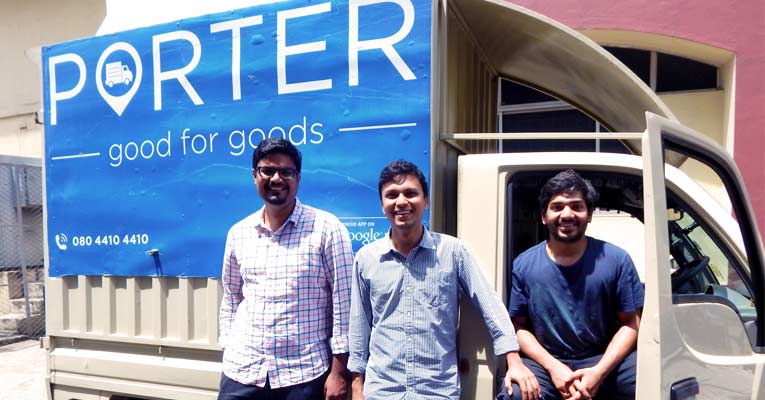FROM MAGAZINE: Interview with Pranav Goel, Co- founder and CEO of Porter: Uncluttering intra-city logistics with technology

Founded by (L to R) Uttam Digga, Pranav Goel, and Vikas Choudhary, Porter has disrupted various domains of logistics by launching an on-demand marketplace for trucks, bikes, and packers & movers in India
Logistics marketplace ‘Porter’ deals in tech-enabled intra-city logistics. The online marketplace offers mini-trucks (LCVs) to SMEs, small businesses and individuals on demand as well as on fixed arrangement basis. Founded in 2014 by three IIT graduates Pranav Goel, Uttam Digga and Vikas Chaudhary, the company seeks to eliminate the inefficiencies existing in the intra city logistics market with the use of its proprietary technology platform. The company has raised Rs 35 crore in Series A funding from Sequoia, Kae Capital and other investors. Pranav Goel, Co- founder and CEO of Porter talks to Shreya Bhattacharya to reveal more…..
India’s logistics sector is burgeoning with several startups. What approaches are you adopting or plan to adopt that would set Porter apart from other logistics solution providers? The intra-city logistics industry mostly works on demand. On demand industry by nature becomes extremely variable. Without a proper tech support, you can't match supply and demand effectively. We come in that space. We match supply and demand effectively using technology. There is a huge advantage we have over other unorganised players, in terms of SLAs, fulfilment and costing. Solving the problem of real time connectivity through technology, I think would be the main differentiator.
How is technology helping you fight the inefficiencies in particular? Most of the companies, have issues with the last mile deliveries. There are four elements in any logistics transaction-loading time, trip time, unloading time and the waiting time between two trips. In India, all these four elements are inefficient. Loading and unloading is usually at the hands of the customer. Customer is inefficient primarily because he is not incentivised to be on time. Furthermore, the industry is extremely unprofessional. Dealing with the drivers is also a challenging part of our job. The customer usually ends up taking time as he always assumes that the driver is going to be late. So, at loading and unloading stations, we keep a per minute charge to incentivise the customer. If he ends up taking more time he ends up paying more.
Secondly, all our vehicles have a smart phone app. All of them are enabled by GPS, also used in Ola and Uber. Since we have visibility on each vehicle so we are able to drive better SLAs. If a vehicle is getting late or the driver has still not left, we reassign the order to another vehicle and penalize the driver so he doesn’t do it again. That’s how the delays are reduced. With this kind of allocation, the expectation of the customer is also set right. Everything is automated, everything is tech driven.
The second trigger is a manual intervention. We have a dispatch centre, which gets alerts about delays. They call the driver asking why he hasn’t left or asks him to leave soon. An automatic message is then sent to the customer apologising about the delay and further informing that the order has been assigned to some other driver. This is how we try to eliminate the inefficiencies in loading unloading.
Coming to the second point, trip time. Currently in intra city logistics every driver has to return empty. On our platform, since we are able to operate on a large scale, around 88 percent of our trips have a return load. No intra city player gives such kind of guarantee on return loads. So the driver is very happy that he doesn’t have to waste his fuel on empty returns. He saves time and money and even earns more money.
Forth was waiting time between two trips. There is a lot of variability in the demand of orders. Sometimes they get orders sometimes they don’t get it for the entire day. At times they get two orders at a time and they can serve only one. Since we have derisked our model by having lots of customers and lots of drivers, the variability factor is not too much here. These efficiencies, I think no one has been able to come close to.
Everything is based on technology- allocation radius, allocation algorithm, ability to drive better SLAs, incentivising all parties, so everyone is more efficient.
How challenging is it for you to convince truck drivers to adopt technology? It’s all about training. We understand the socio-economic background of the driver. They are illiterate or semi illiterate. So we have designed an app, which is colour coded, has symbols and has minimal inputs. So it is easy for them to use. We have presence in five states-Bangalore, Delhi, Mumbai, Hyderabad and Chennai- and every place has a regional language. So by using the app in regional languages, people are able to adopt the technology. We have a training programme and after that we take a test and then only a driver is allowed to work with us.
How much have you gained in terms of business since the inception of Porter? We have more than 3000 vehicles on our platform. And in terms of growth rate we are growing at 10 to 12 percent month on month.
You currently operate only within cities. What are your future expansion plans? Do you also plan to cross state boundaries? We feel that the intra-city logistics is interesting enough. We have a large market and there is a large problem to be solved. We might expand to more markets but we will be doing intra cities only.




